Yanqing Xu
Pinching-Antenna System Design with LoS Blockage: Does In-Waveguide Attenuation Matter?
Aug 10, 2025Abstract:In the literature of pinching-antenna systems, in-waveguide attenuation is often neglected to simplify system design and enable more tractable analysis. However, its effect on overall system performance has received limited attention in the existing literature. While a recent study has shown that, in line-of-sight (LoS)-dominated environments, the data rate loss incurred by omitting in-waveguide attenuation is negligible when the communication area is not excessively large, its effect under more general conditions remains unclear. This work extends the analysis to more realistic scenarios involving arbitrary levels of LoS blockage. We begin by examining a single-user case and derive an explicit expression for the average data rate loss caused by neglecting in-waveguide attenuation. The results demonstrate that, even for large service areas, the rate loss remains negligible under typical LoS blockage conditions. We then consider a more general multi-user scenario, where multiple pinching antennas, each deployed on a separate waveguide, jointly serve multiple users. The objective is to maximize the average sum rate by jointly optimize antenna positions and transmit beamformers to maximize the average sum rate under probabilistic LoS blockage. To solve the resulting stochastic and nonconvex optimization problem, we propose a dynamic sample average approximation (SAA) algorithm. At each iteration, this method replaces the expected objective with an empirical average computed from dynamically regenerated random channel realizations, ensuring that the optimization accurately reflects the current antenna configuration. Extensive simulation results are provided to the proposed algorithm and demonstrate the substantial performance gains of pinching-antenna systems, particularly in environments with significant LoS blockage.
A Gradient Meta-Learning Joint Optimization for Beamforming and Antenna Position in Pinching-Antenna Systems
Jun 14, 2025Abstract:In this paper, we consider a novel optimization design for multi-waveguide pinching-antenna systems, aiming to maximize the weighted sum rate (WSR) by jointly optimizing beamforming coefficients and antenna position. To handle the formulated non-convex problem, a gradient-based meta-learning joint optimization (GML-JO) algorithm is proposed. Specifically, the original problem is initially decomposed into two sub-problems of beamforming optimization and antenna position optimization through equivalent substitution. Then, the convex approximation methods are used to deal with the nonconvex constraints of sub-problems, and two sub-neural networks are constructed to calculate the sub-problems separately. Different from alternating optimization (AO), where two sub-problems are solved alternately and the solutions are influenced by the initial values, two sub-neural networks of proposed GML-JO with fixed channel coefficients are considered as local sub-tasks and the computation results are used to calculate the loss function of joint optimization. Finally, the parameters of sub-networks are updated using the average loss function over different sub-tasks and the solution that is robust to the initial value is obtained. Simulation results demonstrate that the proposed GML-JO algorithm achieves 5.6 bits/s/Hz WSR within 100 iterations, yielding a 32.7\% performance enhancement over conventional AO with substantially reduced computational complexity. Moreover, the proposed GML-JO algorithm is robust to different choices of initialization and yields better performance compared with the existing optimization methods.
Multi-Waveguide Pinching Antennas for ISAC
May 30, 2025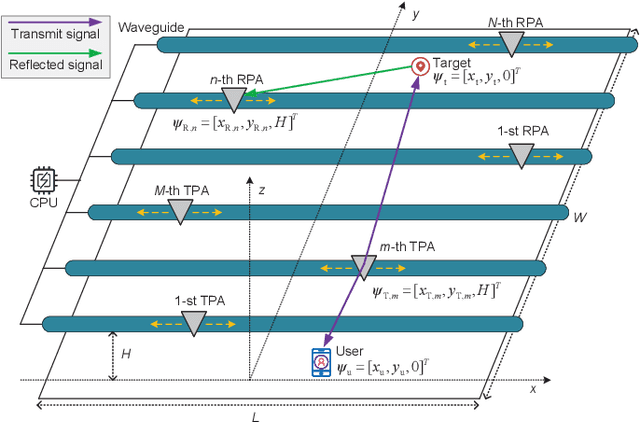
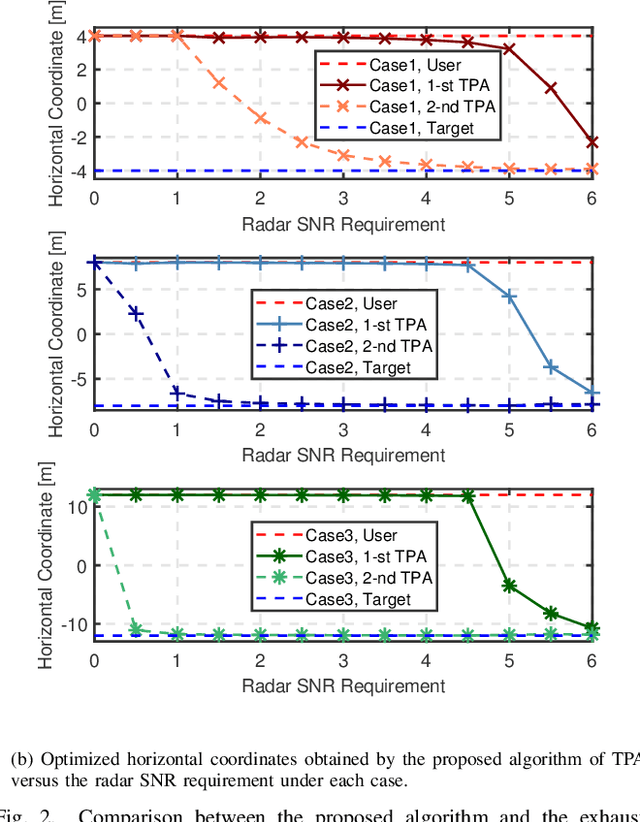
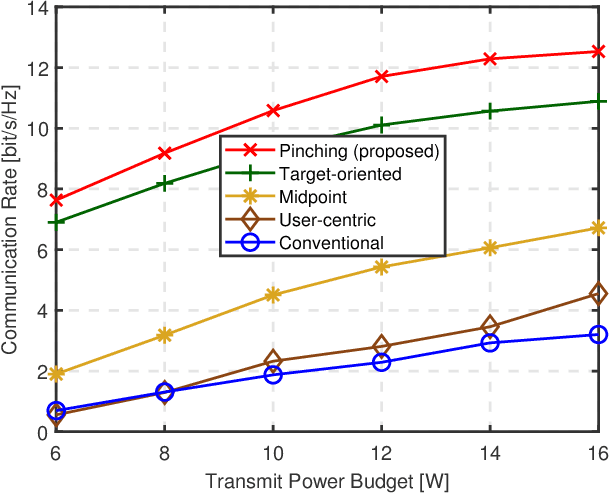
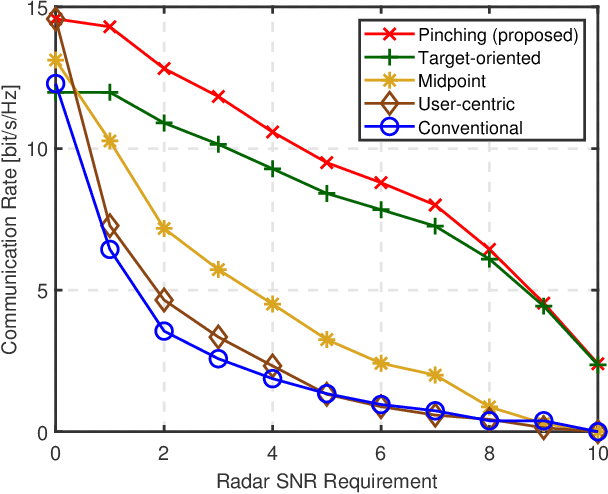
Abstract:Recently, a novel flexible-antenna technology, called pinching antennas, has attracted growing academic interest. By inserting discrete dielectric materials, pinching antennas can be activated at arbitrary points along waveguides, allowing for flexible customization of large-scale path loss. This paper investigates a multi-waveguide pinching-antenna integrated sensing and communications (ISAC) system, where transmit pinching antennas (TPAs) and receive pinching antennas (RPAs) coordinate to simultaneously detect one potential target and serve one downlink user. We formulate a communication rate maximization problem subject to radar signal-to-noise ratio (SNR) requirement, transmit power budget, and the allowable movement region of the TPAs, by jointly optimizing TPA locations and transmit beamforming design. To address the non-convexity of the problem, we propose a novel fine-tuning approximation method to reformulate it into a tractable form, followed by a successive convex approximation (SCA)-based algorithm to obtain the solution efficiently. Extensive simulations validate both the system design and the proposed algorithm. Results show that the proposed method achieves near-optimal performance compared with the computational-intensive exhaustive search-based benchmark, and pinching-antenna ISAC systems exhibit a distinct communication-sensing trade-off compared with conventional systems.
QoS-Aware NOMA Design for Downlink Pinching-Antenna Systems
Apr 18, 2025Abstract:Pinching antennas, implemented by applying small dielectric particles on a waveguide, have emerged as a promising flexible-antenna technology ideal for next-generation wireless communications systems. Unlike conventional flexible-antenna systems, pinching antennas offer the advantage of creating line-of-sight links by enabling antennas to be activated on the waveguide at a location close to the user. This paper investigates a typical two-user non-orthogonal multiple access (NOMA) downlink scenario, where multiple pinching antennas are activated on a single dielectric waveguide to assist NOMA transmission. We formulate the problem of maximizing the data rate of one user subject to the quality-of-service requirement of the other user by jointly optimizing the antenna locations and power allocation coefficients. The formulated problem is nonconvex and difficult to solve due to the impact of antenna locations on large-scale path loss and two types of phase shifts, namely in-waveguide phase shifts and free space propagation phase shifts. To this end, we propose an iterative algorithm based on block coordinate descent and successive convex approximation techniques. Moreover, we consider the special case with a single pinching antenna, which is a simplified version of the multi-antenna case. Although the formulated problem is still nonconvex, by using the inherent features of the formulated problem, we derive the global optimal solution in closed-form, which offers important insights on the performance of pinching-antenna systems. Simulation results demonstrate that the pinching-antenna system significantly outperforms conventional fixed-position antenna systems, and the proposed algorithm achieves performance comparable to the computationally intensive exhaustive search based approach.
Rate Maximization for Downlink Pinching-Antenna Systems
Feb 18, 2025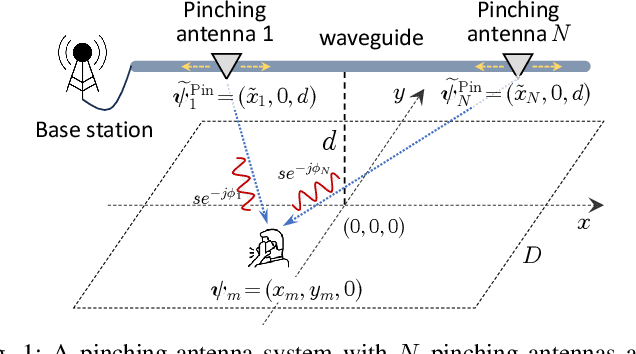

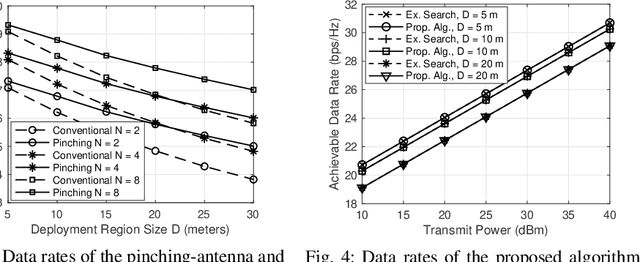
Abstract:In this letter, we consider a new type of flexible-antenna system, termed pinching-antenna, where multiple low-cost pinching antennas, realized by activating small dielectric particles on a dielectric waveguide, are jointly used to serve a single-antenna user. Our goal is to maximize the downlink transmission rate by optimizing the locations of the pinching antennas. However, these locations affect both the path losses and the phase shifts of the user's effective channel gain, making the problem challenging to solve. To address this challenge and solve the problem in a low complexity manner, a relaxed optimization problem is developed that minimizes the impact of path loss while ensuring that the received signals at the user are constructive. This approach leads to a two-stage algorithm: in the first stage, the locations of the pinching antennas are optimized to minimize the large-scale path loss; in the second stage, the antenna locations are refined to maximize the received signal strength. Simulation results show that pinching-antenna systems significantly outperform conventional fixed-location antenna systems, and the proposed algorithm achieves nearly the same performance as the highly complex exhaustive search-based benchmark.
Communication-Efficient Federated Learning by Quantized Variance Reduction for Heterogeneous Wireless Edge Networks
Jan 20, 2025



Abstract:Federated learning (FL) has been recognized as a viable solution for local-privacy-aware collaborative model training in wireless edge networks, but its practical deployment is hindered by the high communication overhead caused by frequent and costly server-device synchronization. Notably, most existing communication-efficient FL algorithms fail to reduce the significant inter-device variance resulting from the prevalent issue of device heterogeneity. This variance severely decelerates algorithm convergence, increasing communication overhead and making it more challenging to achieve a well-performed model. In this paper, we propose a novel communication-efficient FL algorithm, named FedQVR, which relies on a sophisticated variance-reduced scheme to achieve heterogeneity-robustness in the presence of quantized transmission and heterogeneous local updates among active edge devices. Comprehensive theoretical analysis justifies that FedQVR is inherently resilient to device heterogeneity and has a comparable convergence rate even with a small number of quantization bits, yielding significant communication savings. Besides, considering non-ideal wireless channels, we propose FedQVR-E which enhances the convergence of FedQVR by performing joint allocation of bandwidth and quantization bits across devices under constrained transmission delays. Extensive experimental results are also presented to demonstrate the superior performance of the proposed algorithms over their counterparts in terms of both communication efficiency and application performance.
Optimal Joint Fronthaul Compression and Beamforming Design for Networked ISAC Systems
Aug 15, 2024



Abstract:This study investigates a networked integrated sensing and communication (ISAC) system, where multiple base stations (BSs), connected to a central processor (CP) via capacity-limited fronthaul links, cooperatively serve communication users while simultaneously sensing a target. The primary objective is to minimize the total transmit power while meeting the signal-to-interference-plus-noise ratio (SINR) requirements for communication and sensing under fronthaul capacity constraints, resulting in a joint fronthaul compression and beamforming design (J-FCBD) problem. We demonstrate that the optimal fronthaul compression variables can be determined in closed form alongside the beamformers, a novel finding in this field. Leveraging this insight, we show that the remaining beamforming design problem can be solved globally using the semidefinite relaxation (SDR) technique, albeit with considerable complexity. Furthermore, the tightness of its SDR reveals zero duality gap between the considered problem and its Lagrangian dual. Building on this duality result, we exploit the novel UL-DL duality within the ISAC framework to develop an efficient primal-dual (PD)-based algorithm. The algorithm alternates between solving beamforming with a fixed dual variable via fixed-point iteration and updating dual variable via bisection, ensuring global optimality and achieving high efficiency due to the computationally inexpensive iterations. Numerical results confirm the global optimality, effectiveness, and efficiency of the proposed PD-based algorithm.
Distributed Signal Processing for Extremely Large-Scale Antenna Array Systems: State-of-the-Art and Future Directions
Jul 23, 2024Abstract:Extremely large-scale antenna arrays (ELAA) play a critical role in enabling the functionalities of next generation wireless communication systems. However, as the number of antennas increases, ELAA systems face significant bottlenecks, such as excessive interconnection costs and high computational complexity. Efficient distributed signal processing (SP) algorithms show great promise in overcoming these challenges. In this paper, we provide a comprehensive overview of distributed SP algorithms for ELAA systems, tailored to address these bottlenecks. We start by presenting three representative forms of ELAA systems: single-base station ELAA systems, coordinated distributed antenna systems, and ELAA systems integrated with emerging technologies. For each form, we review the associated distributed SP algorithms in the literature. Additionally, we outline several important future research directions that are essential for improving the performance and practicality of ELAA systems.
Beyond ADMM: A Unified Client-variance-reduced Adaptive Federated Learning Framework
Dec 03, 2022



Abstract:As a novel distributed learning paradigm, federated learning (FL) faces serious challenges in dealing with massive clients with heterogeneous data distribution and computation and communication resources. Various client-variance-reduction schemes and client sampling strategies have been respectively introduced to improve the robustness of FL. Among others, primal-dual algorithms such as the alternating direction of method multipliers (ADMM) have been found being resilient to data distribution and outperform most of the primal-only FL algorithms. However, the reason behind remains a mystery still. In this paper, we firstly reveal the fact that the federated ADMM is essentially a client-variance-reduced algorithm. While this explains the inherent robustness of federated ADMM, the vanilla version of it lacks the ability to be adaptive to the degree of client heterogeneity. Besides, the global model at the server under client sampling is biased which slows down the practical convergence. To go beyond ADMM, we propose a novel primal-dual FL algorithm, termed FedVRA, that allows one to adaptively control the variance-reduction level and biasness of the global model. In addition, FedVRA unifies several representative FL algorithms in the sense that they are either special instances of FedVRA or are close to it. Extensions of FedVRA to semi/un-supervised learning are also presented. Experiments based on (semi-)supervised image classification tasks demonstrate superiority of FedVRA over the existing schemes in learning scenarios with massive heterogeneous clients and client sampling.
Low-Complexity Channel Estimation for Massive MIMO Systems with Decentralized Baseband Processing
Oct 28, 2022



Abstract:The traditional centralized baseband processing architecture is faced with the bottlenecks of high computation complexity and excessive fronthaul communication, especially when the number of antennas at the base station (BS) is large. To cope with these two challenges, the decentralized baseband processing (DPB) architecture has been proposed, where the BS antennas are partitioned into multiple clusters, and each is connected to a local baseband unit (BBU). In this paper, we are interested in the low-complexity distributed channel estimation (CE) method under such DBP architecture, which is rarely studied in the literature. The aim is to devise distributed CE algorithms that can perform as well as the centralized scheme but with a small inter-BBU communication cost. Specifically, based on the low-complexity diagonal minimum mean square error channel estimator, we propose two distributed CE algorithms, namely the aggregate-then-estimate algorithm and the estimate-then-aggregate algorithm. In contrast to the existing distributed CE algorithm which requires iterative information exchanges among the nodes, our algorithms only require one roundtrip communication among BBUs. Extensive experiment results are presented to demonstrate the advantages of the proposed distributed CE algorithms in terms of estimation accuracy, inter-BBU communication cost, and computation complexity.
 Add to Chrome
Add to Chrome Add to Firefox
Add to Firefox Add to Edge
Add to Edge